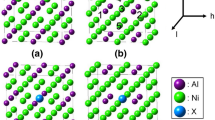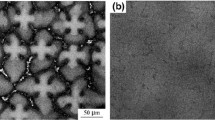Abstract
The γ/γ’ phase interface, being the main plane defect in nickel-based single-crystal superalloys, can have a significant effect on the microstructural stability and mechanical properties of superalloys. To improve the thermodynamic stability and fracture strength of the γ-Ni/γ’-Ni3Al interface and gain insight into the underlying micro-mechanisms, the segregation tendency of 12 alloying elements X at the γ-Ni/γ’-Ni3Al interface and their effects on the interfacial formation and Griffith fracture works were investigated by using first-principles calculations. It is found that all alloying elements X can segregate to the corner-point site of the γ-Ni (001) layer except the element Y. The Re-, Ti-, Mo-, W-, Cr-, Nb-, Ta-, Hf- and Zr-segregated interfaces are more stable than the unalloyed interface due to the presence of pseudogap and lower values of densities of states at the Fermi level. The segregation of Ru, Co, Re, Mo, W, Cr, Nb and Ta strengthens the interfacial fracture strength, which can be mainly attributed to the enhanced bonding strengths of X–Ni bonds formed in these segregated interfaces. The interfacial segregation of Cr, Re, Mo, W, Nb and Ta can not only improve the thermodynamic stability but also enhance the fracture strength of the phase interface. The segregation of Ta and Re is able to improve the thermodynamic stability and fracture strength of the γ-Ni/γ’-Ni3Al interface to the maximum extent, respectively.
Graphic abstract
The effect of interfacial segregation of alloying elements on the fracture strength and thermodynamic stability of the γ-Ni/γ’-Ni3Al phase interface and the underlying mechanisms are studied.










Similar content being viewed by others
References
Hou H, Wen Z, Zhao Y, Fu L, Wang N, Han P (2014) First-principles investigations on structural, elastic, thermodynamic and electronic properties of Ni3X (X = Al, Ga and Ge) under pressure. Intermetallics 44:110–115
Sun M, Wang CY (2016) First principles study of the diffusional phenomena across the clean and Re-doped γ-Ni/γ’-Ni3Al interface of Ni-based single crystal superalloy. Chin Phys B 6:397–406
Bochenek K, Basista M (2015) Advances in processing of NiAl intermetallic alloys and composites for high temperature aerospace applications. Prog Aerosp Sci 79:136–146
Le Graverend JB, Jacques A, Cormier J, Ferry O, Schenk T, Mendez J (2015) Creep of a nickel-based single-crystal superalloy during very high-temperature jumps followed by synchrotron X-ray diffraction. Acta Mater 84:65–79
Lv X, Zhang J (2017) Core structure of a < 100 > interf acial superdislocations in a nickel-base superalloy during high-temperature and low-stress creep. Mater Sci Eng, A 683:9–14
Ru Y, Li S, Zhou J, Pei Y, Wang H, Gong S, Xu H (2016) Dislocation network with pair-coupling structure in 111 γ/γ′ interface of Ni-based single crystal superalloy. Sci Rep 6:1–9
Bagot PA, Silk OB, Douglas JO, Pedrazzini S, Crudden DJ, Martin TL, Hardy MC, Moody MP, Reed RC (2017) An Atom Probe Tomography study of site preference and partitioning in a nickel-based superalloy. Acta Mater 125:156–165
Tu Y, Mao Z, Seidman DN (2012) Phase-partitioning and site-substitution patterns of molybdenum in a model Ni–Al–Mo superalloy: an atom-probe tomographic and first-principles study. Appl Phys Lett 101:121910–121914
Amouyal Y, Mao Z, Seidman DN (2010) Effects of tantalum on the partitioning of tungsten between the γ-and γ′-phases in nickel-based superalloys: linking experimental and computational approaches. Acta Mater 18:5898–5911
Ding Q, Li S, Chen LQ, Han X, Zhang Z, Yu Q, Li J (2018) Re segregation at interfacial dislocation network in a nickel-based superalloy. Acta Mater 154:137–146
Huang M, Cheng Z, Xiong J, Li J, Hu J, Liu Z, Zhu J (2014) Coupling between Re segregation and γ/γ′ interfacial dislocations during high-temperature, low-stress creep of a nickel-based single-crystal superalloy. Acta Mater 76:294–305
Raabe D, Sandlöbes S, Millán J, Ponge D, Assadi H, Herbig M, Choi PP (2013) Segregation engineering enables nanoscale martensite to austenite phase transformation at grain boundaries: a pathway to ductile martensite. Acta Mater 16:6132–6152
Raabe D, Herbig M, Sandlöbes S, Li Y, Tytko D, Kuzmina M, Ponge D, Choi PP (2014) Grain boundary segregation engineering in metallic alloys: a pathway to the design of interfaces. Curr Opin Solid State Mater Sci 18:253–261
Xiong H, Liu Z, Zhang H, Du Z, Chen C (2017) First principles calculation of interfacial stability, energy and electronic properties of SiC/ZrB2 interface. J Phys Chem Solids 107:162–169
Mahjoub R, Laws KJ, Stanford N, Ferry M (2018) General trends between solute segregation tendency and grain boundary character in aluminum: an ab inito study. Acta Mater 158:257–268
Razumovskiy VI, Lozovoi AY, Razumovskii IM (2015) First-principles-aided design of a new Ni-base superalloy: influence of transition metal alloying elements on grain boundary and bulk cohesion. Acta Mater 82:369–377
Yamaguchi M, Shiga M, Kaburaki H (2005) Grain boundary decohesion by impurity segregation in a nickel-sulfur system. Science 307:393–397
Zhang S, Kontsevoi OY, Freeman AJ, Olson GB (2011) First principles investigation of zinc-induced embrittlement in an aluminum grain boundary. Acta Mater 59:6155–6167
Nie JF, Zhu YM, Liu JZ, Fang XY (2013) Periodic segregation of solute atoms in fully coherent twin boundaries. Science 340:957–960
Tsuru T, Somekawa H, Chrzan DC (2018) Interfacial segregation and fracture in Mg-based binary alloys: experimental and first-principles perspective. Acta Mater 151:78–86
Bauer KD, Todorova M, Hingerl K, Neugebauer J (2015) A first principles investigation of zinc induced embrittlement at grain boundaries in bcc iron. Acta Mater 90:69–76
Wang J, Janisch R, Madsen GK, Drautz R (2016) First-principles study of carbon segregation in bcc iron symmetrical tilt grain boundaries. Acta Mater 115:259–268
Kang J, Glatzmaier GC, Wei SH (2013) Origin of the bismuth-induced decohesion of nickel and copper grain boundaries. Phys Rev Lett 111:055502–055505
Gong XF, Yang GX, Fu YH, Xie YQ, Zhuang J, Ning XJ (2009) First-principles study of Ni/Ni3Al interface strengthening by alloying elements. Comput Mater Sci 47:320–325
Wang C, Wang CY (2008) Density functional theory study of Ni/Ni3Al interface alloying with Re and Ru. Surf Sci 602:2604–2609
Chen K, Zhao LR, John ST (2003) Synergetic effect of Re and Ru on γ/γ′ interface strengthening of Ni-base single crystal superalloys. Mater Sci Eng, A 360:197–201
Zhu T, Wang CY, Gan Y (2010) Effect of Re in γ phase, γ′ phase and γ/γ′ interface of Ni-based single-crystal superalloys. Acta Mater 58:2045–2055
Wang YJ, Wang CY (2008) A first-principles survey of the partitioning behaviors of alloying elements on γ/γ′ interface. J Appl Phys 104:013109
Peng P, Soh AK, Yang R, Hu ZQ (2006) First-principles study of alloying effect of Re on properties of Ni/Ni3Al interface. Comput Mater Sci 38:354–361
Peng L, Peng P, Liu YG, He S, Wei H, Jin T, Hu ZQ (2012) The correlation between Re and P and their synergetic effect on the rupture strength of the γ-Ni/γ′-Ni3Al interface. Comput Mater Sci 63:292–302
Cheng YW, Tang FL, Xue HT, Liu HX, Gao B, Feng YD (2016) Bonding and electronic properties of the Cu2ZnSnS4/WZ–ZnO interface from first-principles calculations. J Phys D Appl Phys 49:285107–285110
Kresse G, Furthmüller J (1996) Efficient iterative schemes for ab initio total-energy calculations using a plane-wave basis set. Phys Rev B 54:11169–11186
Kresse G, Furthmüller J (1996) Efficiency of ab initio total energy calculations for metals and semiconductors using a plane-wave basis set. Comput Mater Sci 6:15–50
Perdew JP, Burke K, Ernzerhof M (1996) Generalized gradient approximation made simple. Phys Rev Lett 77:3865–3868
Kresse G, Joubert D (1999) From ultrasoft pseudopotentials to the projector augmented-wave method. Phys Rev B 59:1758–1775
Tian D, Chen Y, Jiang Y, Yi Z, Peng P (2018) Effect of P-doping on the rupture strength of γ-Ni/γ’-Ni3Al interfaces. IOP Conf Ser Mater Sci Eng 381:012161–012169
Wu X, You YW, Kong XS, Chen JL, Luo GN, Lu GH, Liu CS, Wang Z (2016) First-principles determination of grain boundary strengthening in tungsten: dependence on grain boundary structure and metallic radius of solute. Acta Mater 120:315–326
He S, Peng P, Peng L, Chen Y, Wei H, Hu ZQ (2014) An interplay of sulfur and phosphorus at the γ-Ni/γ′-Ni3Al interface. J Alloys Compd 597:243–248
Peng L, Peng P, Wen DD, Liu YG, Wei H, Sun XF, Hu ZQ (2011) Site preference of S-doping and its influence on the properties of a Ni/Ni3Al interface. Modell Simul Mater Sci Eng 19:065002–065016
Zhao W, Sun Z, Gong S (2017) Vacancy mediated alloying strengthening effects on γ/γ′ interface of Ni-based single crystal superalloys: a first-principles study. Acta Mater 135:25–34
Du YL, Sun ZM, Hashimoto H (2010) First-principles study on phase stability and compression behavior of Ti2SC and Ti2AlC. Phys B 405:720–723
Shi YJ, Du YL, Chen G, Chen GL (2007) First principle study on phase stability and electronic structure of YCu. Phys Lett A 368:495–498
Acknowledgements
This work was financially supported by the Ministry of Science and Technology of China (Grant No. 2017YFA0700701), the Joint Fund between Shenyang National Laboratory for Materials Science and State Key Laboratory of Advanced Processing and Recycling of Nonferrous Metals (Grant No. 18LHPY003), the National Natural Science Foundation of China (Grant No. 11764027) and the Hongliu Excellent Young Talents Support Program of Lanzhou University of Technology. This work was performed in the Gansu Supercomputer Center.
Author information
Authors and Affiliations
Corresponding authors
Additional information
Publisher's Note
Springer Nature remains neutral with regard to jurisdictional claims in published maps and institutional affiliations.
Rights and permissions
About this article
Cite this article
Ahmed, F.A.M., Xue, HT., Tang, FL. et al. Segregation of alloying elements and their effects on the thermodynamic stability and fracture strength of γ-Ni/γ′-Ni3Al interface. J Mater Sci 55, 12513–12524 (2020). https://doi.org/10.1007/s10853-020-04854-6
Received:
Accepted:
Published:
Issue Date:
DOI: https://doi.org/10.1007/s10853-020-04854-6




